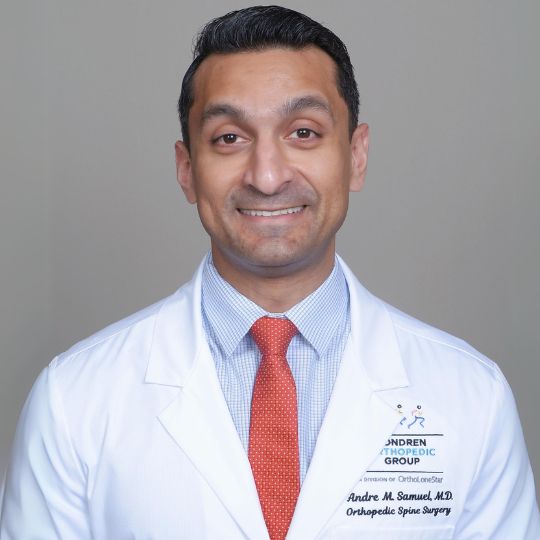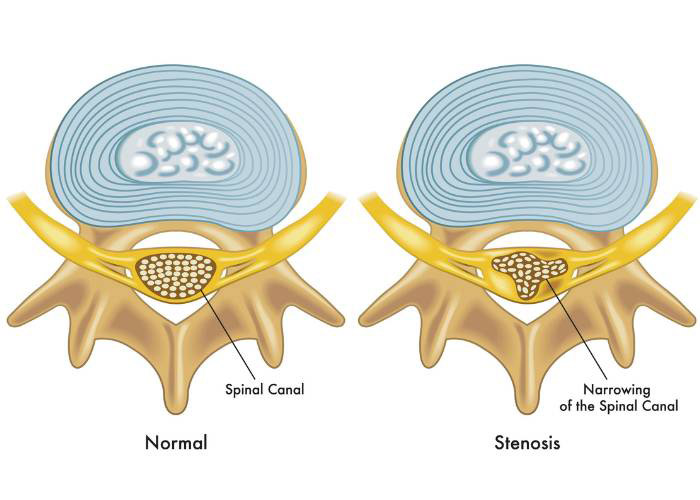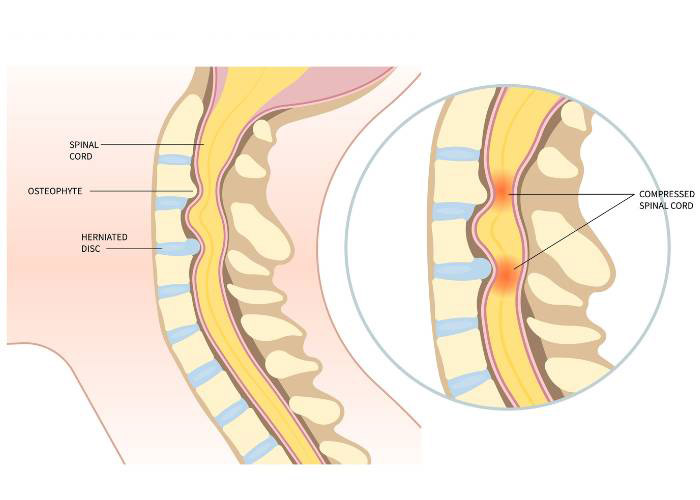Cervical Stenosis and Myelopathy Specialist
Do you have neck pain that has caused a decrease in sensation in the upper extremities or loss of muscle strength? If so, you may have a spine condition called cervical stenosis. Cervical stenosis can be treated both surgically or non-surgically. Doctor Andre M. Samuel, orthopedic spine specialist, serves Clear Lake, Houston, and Sugar Land, Texas area and patients who may have cervical stenosis. Contact Dr. Samuel’s team today.

What is cervical stenosis?
The spinal column begins at the base of the skull and houses the network of nerves and the spinal cord that carry electrical messages to all parts of the body. The first seven vertebrae of the spinal column form the cervical spine which makes up the neck. The bony openings of the vertebrae also the nerve controlling the arms to exit. These openings may narrow with the normal aging process causing pressure and irritation to these cervical spine nerve roots. Narrowing of the spinal canal itself is called spinal stenosis, which can result in compression of the spinal cord or the spinal nerve roots the control the arms. While adults over the age of 40 have a higher risk of developing cervical stenosis, a small number of individuals have a congenital variation where they are born with an already narrowed spinal canal.

What is cervical spondylotic myelopathy?
As individuals age, the spinal cord can become compressed which may cause a steady progression of symptoms. This neck condition is known as cervical spondylotic myelopathy (CSM). Individuals with this condition can experience a wide range of symptoms including severe neck pain and stiffness, numbness and/or tingling in the hands and fingers, loss of hand dexterity, difficulty with coordination or walking balance, and progressive weakness in the arms or legs. Dr. Andre M. Samuel, orthopedic spinal specialist serving Clear Lake, Houston, and Sugar Land, Texas area, has the knowledge and understanding, as well as substantial experience, in treating patients who have experienced cervical stenosis or cervical spondylotic myelopathy.

What are the symptoms of cervical stenosis?
Because cervical stenosis slowly progresses with time, it is common for symptoms to also slowly progress with time. Some individuals may not experience any symptoms until the cervical spine becomes severely narrowed. Common symptoms of cervical stenosis include:
- Decreased sensation of the upper extremities
- Loss of upper or lower extremity muscle strength
- Difficulty with walking balance and coordination skills
- Fine motor skills, such as handwriting, are also affected
How is cervical stenosis diagnosed?
A medical history will be obtained by Dr. Samuel followed by a physical and neurological examination. Motor skills, sensation, muscle strength, and nerve reflex abnormalities are evaluated in the neck and upper extremities. Advanced imaging studies, such as magnetic resonance imaging (MRI) and computed tomography (CT), can help identify the affected cervical nerve root. Nerve conduction studies such as a myelogram may be requested to determine the extent of nerve damage.
What is the treatment for cervical stenosis?
Non-surgical treatment:
Conservative treatment measures do not directly address the narrowed spinal canal, the majority of patients report symptom relief with these non-surgical therapies. Non-steroidal anti-inflammatory medications (NSAIDs) decrease inflammation and alleviate muscle pain. An epidural steroid injection can be administered near the affected nerve root to further relieve symptoms of pain and inflammation. However, in cases of severe spinal cord compression, Dr. Samuel will often recommend early surgical treatment, in order to avoid permanent spinal cord damage and prevent ongoing loss of function.
Surgical treatment:
With the recent advancements in surgical technology, there are several techniques that Dr. Samuel can perform to correct cervical stenosis. Individuals with continued and worsening symptoms despite conservative management are good surgical candidates. The best surgical procedure will be determined upon Dr. Samuel’s review of patient-specific factors such as medical history, current symptoms, and desired outcomes.
- Cervical Disc Replacement (CDR): The herniated disc is completely removed from an incision on the front of the neck and replaced with an artificial disc that preserves motion. Can be used to treat one to two levels of stenosis
- Anterior Cervical Discectomy & Fusion (ACDF). The ruptured disc is completely removed from an incision on the front of the neck. The space is then filled with a bone graft that will fuse to the surrounding vertebrae. This is used for treating discs that have also become severely arthritic.
- Posterior Cervical Laminoplasty: This is a motion-preserving technique where the spinal canal in enlarged through an incision in the back of the neck. By preserving at the spinal facet joints and disc, no fusion or loss of neck motion is necessary.



